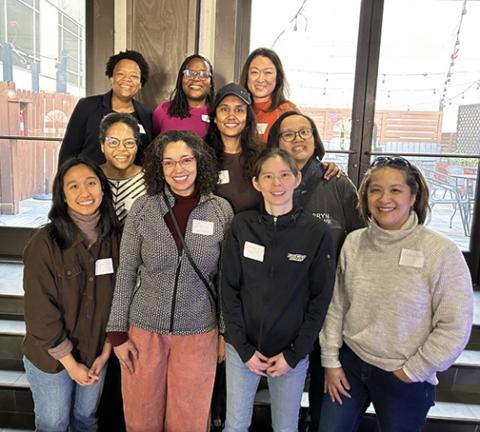A Unity Trip to D.C. for BIPOC Mawrters
BIPOC students and alumnae/i took a spring break trip together to connect and to discuss the intersection of their respective identities.
For the second consecutive year, BIPOC (Black, Indigenous, people of color)students and alumnae/i took a spring break trip together to connect and to discuss the intersection of their respective identities.
The idea for the Unity Trip originated with Mammie Barry ’22 and Shaylin Chaney-Williams ’22 with support from Joi Dallas, assistant dean of intercultural engagement, and student participation was sponsored by the Impact (formerly Pensby) Center. In 2022, the trip focused on the Black/African Diaspora experience in New York City. This year, it was designed around the Asian American experience in Washington, D.C. Thoughtful discussions on both trips included the recognition that Black and Asian identities are not a monolith.
Mariejoy Mendoza-Riess ’01, Tapestry working committee member, served as this year’s alumnae/i leader and partnered with BIPOC Mawrters and the Alumnae/i Relations and Development Office to create a daylong experience. Here are some of her reflections after the trip:
You traveled from Sacramento, California, and other Mawrters on the trip came from Ottawa, Canada; New York; and the D.C. area. What motivated you to attend?
Often, people of color are navigating white-dominated places. It is rare to have a space where you can safely and non-judgmentally discuss race and gender. There are even fewer opportunities to have these conversations with fellow BIPOC Mawrters. I am so grateful that I had the opportunity to meet new alums on this trip, and we are already exchanging emails and staying in touch.
What were the highlights of the trip for you?
Connecting with students. I have to give them kudos for being brave enough to ask us alumnae/i questions and for supporting a safe space for us all to be honest and vulnerable. I felt reenergized and reinvigorated because of the conversations I had. And it was fun! The Unity Trip wasn’t a vacation, but it was a retreat from my daily life. When we participated in Bharatnatyam dance, we got to appreciate an art form and could lose ourselves in the movement. We also got to eat great Laotian food from a woman-owned business, and we had the opportunity to simply hang out. Emily Murase ’87 [Tapestry co-chair] said it best: “When you get a couple of Mawrters in the room, magic happens.”
What is the purpose of the Unity Trip?
This year we focused on the Asian American experience, an identity I hold. Last year, we focused on the Black/African American experience. I am never going to know what it is like to be a Black or Latinx person in America, but there are commonalities that we do share. We are all impacted by systemic racism. It touches all our communities. When a highway or stadium is put in a community like DC’s Chinatown, that is the kind of experience that other BIPOC folks have gone through as well. We can all learn from each other and be allies for one another.
Published on: 06/02/2023
